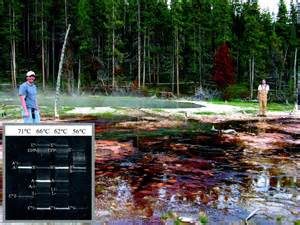
Image: Mushroom Spring, Yellowstone National Park, where Thermus Aquaticus was found in 1966 by Dr. Thomas Brock

Image: Dr. Thomas Brock
In 1966, Dr. Thomas Brock studied a pink bacterial sample from a Yellowstone hot spring. Little did he know he had discovered an organism which would make DNA and other microbial analyses practical and affordable.
Brock, a scientist who had enhanced his education by self-teaching in microbiology, collected, along with undergraduate student Hudson Freeze, the sample from a bacterial mat at Mushroom Spring, in Yellowstone National Park.
From that bacterial sample, Brock and Freeze isolated an organism thriving at 70°C (160°F) which they named Thermus aquaticus.
No one knew at the time that the ability of T. aquaticus to tolerate high heat would make possible the isolation of an enzymatic (or polymerase) chain reaction which would be the basis of a Nobel Prize for another scientist, Dr. Kary B. Mullis, who utilized Polymerase Chain Reaction (PCR) to make DNA analysis a faster, and therefore, more affordable, process.
Now, a new testing platform has been discovered from an organism (not specifically named) found at Yellowstone a few years ago.
While Curtis Knox, company spokesman, describes his company’s efforts, you will need to read on to the next pages to see the science and exploration which set the groundwork for the new technology.
Two years ago, no one could’ve predicted the worst Ebola outbreak in history would hit West Africa this year. And Lucigen—a small Wisconsin life sciences company with a federal grant to develop a simpler, faster test for diagnosing serious pathogens—certainly didn’t expect to play a part in the effort to assess and contain the deadly disease.
But a couple of months ago, the Centers for Disease Control and Prevention contacted Lucigen about the rapid, on-the-spot pathogen detection technology that the 52-person company has been developing in Middleton, WI. Lucigen, founded in 1998 as a supplier of life sciences research products, had in 2012 won a three-year, $1.7 million grant from the National Institute of Allergy and Infectious Diseases to help further development of the diagnostic technology.
The idea is a nucleic-acid-based test for quickly spotting infections in patients’ samples right at the point of care in, say, a hospital or doctor’s office. The technology has a multitude of applications, Lucigen says, from sniffing out common infections like flu and strep to diagnosing more serious diseases—including Ebola.
Lucigen’s technology drew the CDC’s attention because the diagnostic test can be performed by healthcare workers in the field, and it returns results within 30 minutes or so. That would be a huge improvement over the current practice of shipping samples to a far-away lab for testing by highly trained technicians, a process that typically doesn’t return results for a couple of days.
. . . the Ebola outbreak has spurred more urgent demand for Lucigen’s new—and still largely unproven—technology.
See the rest of this article here.
The relationship of Lucigen’s rapid-diagnostic method to the Yellowstone thermophile is more particularly described in this artcle:
Enzymes from Yellowstone National Park’s thermal features are the basis of a potential Ebola field diagnosis tool — the first of its kind that could be key in containing spread of the disease.
Middleton (Wis.)-based Lucigen Corp. is seeking emergency U.S. Food and Drug Administration approval for a new portable Ebola diagnostic tool that can be used anywhere in the field. Though Lucigen is seeking emergency approval, the tool has been in development for a decade, since researchers with the firm began using enzymes found in Yellowstone National Park thermals, including Octopus Spring (found in the Lower Geyser Basin), as the basis for research. From the Wisconsin State Journal:
Derived from enzymes discovered in the hot springs of Yellowstone National Park more than a decade ago, the test already is being tried in parts of West Africa where Ebola has spread. A U.S. government agency is evaluating its performance against other tests, said Hemanth Shenoi, Lucigen’s director of business development. He declined to say which agency.
“In cases like Ebola, time is of the essence,” Shenoi said. He said Lucigen has been in discussions with the FDA over the past week but does not know how soon a decision may come.
Source: Yellowstone Insider Editor
See the rest of this article, including discussion of Lucigen’s research, here.
Such articles as the above cover the important practicalities of bringing an advance in science into use.
Click on the next page numbers to see the Yellowstone environment and science behind the discoveries.
- Colors of Yellowstone hot springs reflect chemical reactions and heat-loving organisms.
- Bacterial mats occur where hot springs spill over warm earth.
- Extremophiles, organisms which live in extreme conditions, may reveal the first life forms on an earth without oxygen.
- Extremophiles suggest potential life forms in outer space.
- Thermus (T) Aquaticus (aq) and its enzyme/polymerase (Taq) has the ability to speed up diagnostics at the microbe level.



